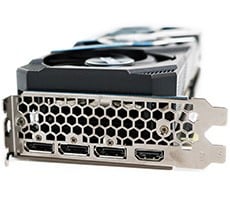XFX GeForce 7950 GT 570M Extreme
For our next set of performance metrics, we spent a little time overclocking the XFX GeForce 7950 GT 570M Extreme using the clock frequency slider available within NVIDIA's Forceware Rel. 90 drivers after enabling the "Coolbits" registry tweak.
|
|
|
To find the card's peak core and memory frequencies, we slowly raised their respective sliders until we begun to see visual artifacts on-screen while running a game or benchmark, or until our test system was no longer stable.

XFX GeForce 7950 GT Overclocked Speeds: 596MHz Core / 791MHz (1.58GHz DDR) Memory
XFX GeForce 7950 GT Stock Speeds: 570MHz Core / 730MHz (1.46GHz DDR) Memory
GeForce 7950 GT Stock Speeds: 550MHz Core / 700MHz (1.4GHz DDR) Memory

XFX GeForce 7950 GT Overclocked Speeds: 596MHz Core / 791MHz (1.58GHz DDR) Memory
XFX GeForce 7950 GT Stock Speeds: 570MHz Core / 730MHz (1.46GHz DDR) Memory
GeForce 7950 GT Stock Speeds: 550MHz Core / 700MHz (1.4GHz DDR) Memory
The XFX GeForce 7950 GT 570M Extreme proved to be a decent overclocker, despite the fact that the card is equipped with a passive cooler and is already overclocked from the factory. When all was said and done, we were able to take the XFX GeForce 7950 GT 570M Extreme up from its default GPU and memory clocks of 570MHz and 730MHz to 596MHz / 791MHz.
While we had the card overclocked, we re-ran a couple of benchmarks to see what kind of performance we had gained. Performance in the F.E.A.R benchmark went up by 2 frames per second to 44, and the Prey benchmark went form 49.8 to 53.7, and increase of about 7.8 %. In fact, overclocking the XFX GeForce 7950 GT 570M Extreme gave it an edge over the 256MB Radeon X1900 XT in the Prey benchmark -- something it didn't have while running it is default configuration.







